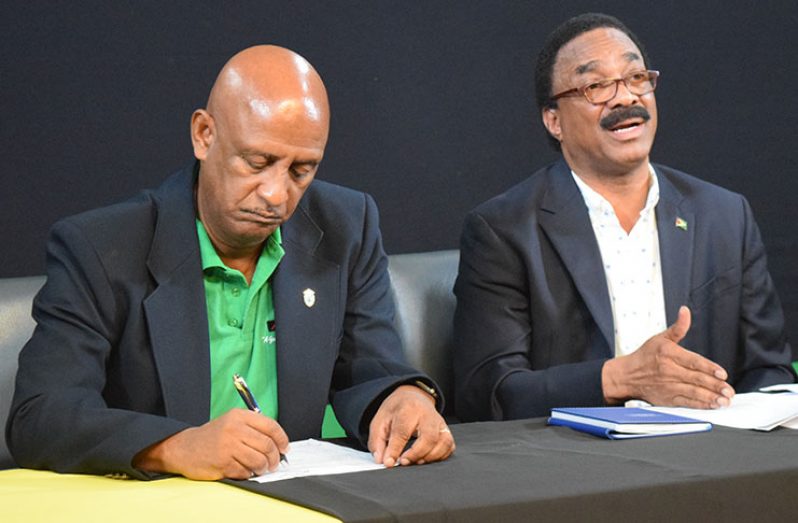-Jagdeo had refused to approve lease
-lease did not include building
CONTRARY to the law, no sanction and or approval was given by then Presidents Bharrat Jagdeo and Donald Ramotar for the Cheddi Jagan Research Centre Incorporated (CJRCI) to lease lots 65-67 High Street, which houses the famous Red House.
This was according to Attorney General (AG) and Minister of Legal Affairs, Basil Williams who, at a Saturday afternoon press conference, detailed the series of events which led to a recent presidential revocation of the lease.
Having its genesis in late 2000, custody of the famous Red House was handed to the National Trust and became a heritage site and National Monument.
Since then, efforts were made by CJRCI in 2000, 2006, 2010 and 2011 to have then President Bharrat Jagdeo and his successor Donald Ramotar give their approval for the lease.
According to Section 10 of the Land Department Act Chapter 59:01: “Government lands shall only be rented or sold with the sanction of the President and on the terms and conditions determined by him.”
And with the plots of land in question being Government lands, approval or sanction by the then President was needed. However, the Attorney General revealed that no such sanction or approval was ever given during the years spanning both presidencies.
“In January 2011, then President Jagdeo withheld his approval because he did not want the shadow of the late President Cheddi Jagan like an albatross around his neck during his tenure. When he left office, his successor President Ramotar also did not sign it either. So there was no Presidential signature as is required by the section,” the Legal Affairs Minister said.
He further explained that State lands are converted into Government lands when the President issues a grant to the Commissioner of lands. All Government lands rest with the commissioner of lands and survey.
As such, Minister Williams said that since the commissioner is the custodian, he can make a lease with anybody, but no one would necessarily know he had authority to do that. As a result, the Section made the provision that he (the commissioner) could not execute any lease without the sanction and or approval of the President.
And with the lease not having authorisation by the President, the Attorney General contended that this is an offense which is punishable by up to 10 years imprisonment.
He explained too that the land subject to that lease did not include the building on the property which was also utilised by the CJRCI.
NOT INCLUDED
“The building itself was not included in the lease. If you’re going to include building with lands, you have to say lot 65, 66, 67, with the building and erection thereon. It wasn’t included because they knew they couldn’t lease or sell a National Heritage Monument,” Williams said, adding that the actual building is property of the National Trust and that the building could not be sold, leased, or otherwise disposed of without the sanction of the minister/President.
The minister pointed out that it was discovered by the Government that there was a draft lease between the National Trust, the then Government and the CJRCI for the building to be leased, but that it was never signed.
On the other hand, the 99 year lease for the plots of land, was to be governed by the Deeds Registry Act which deals with lease for 21 or more years. Such lease, the Act states, must be executed in the manner of a transport.
And according to Minister Williams, what this means is that a transparent process of publishing the transaction in the Gazette takes effect.
Additionally, the transaction is to be advertised in a national newspaper of wide circulation. The reason for this, he explained, is that if any individual wants to make an objection to the transfer of the land, they could file a notice of opposition having seen the advertisement.
He said that after that, if no notice of opposition is filed, the transaction is passed before the court.
“So it is a transparent process, but that process was never undertaken by the persons who dealt with that lease. In other words, it was a deliberate attempt to hide that transaction from the eyes of the Guyanese people because they knew such a transaction was unlawful and illegal under the laws,” he contended.
Additionally, he noted that the Deeds Registry Act require such lease be filed as a matter of record, and it must be annotated. However, these were not done in this case since documents in his possession show that the last annotation was done in 1925.
“So the important thing about being filed and annotated is that if these weren’t done, then you couldn’t plea it in any court of law; you couldn’t assert it in any court of law” he said, adding that this matter which is before the court will not last very long.
However, former AG Anil Nandlall believes that Williams’ contention that the lease is invalid because the President “did not ‘sanction’ it, is flawed and manifestly wrong.
Nandlall argued that any person knowledgeable of the law should know that in the State Lands Act, the Land Department Act and similar types of legislation, the power to lease, sell or grant licenses resides with the President.He (the President) is empowered to delegate such authority to the Commissioner of Lands and Surveys, the Commissioner of Forestry or the Commissioner of Geology and Mines or the Manager of the MMA/DA.
These, he said, would depend on the nature of the land and the purpose for which it is to be used.




.jpg)










